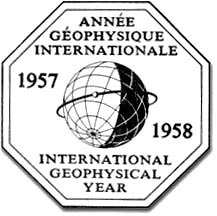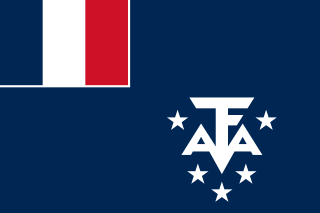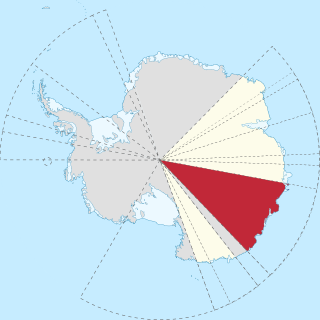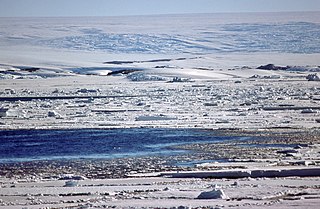
Sir Ernest Henry Shackleton was an Anglo-Irish Antarctic explorer who led three British expeditions to the Antarctic. He was one of the principal figures of the period known as the Heroic Age of Antarctic Exploration.

Sir Douglas Mawson was a British-born Australian geologist, Antarctic explorer, and academic. Along with Roald Amundsen, Robert Falcon Scott, and Sir Ernest Shackleton, he was a key expedition leader during the Heroic Age of Antarctic Exploration.

The International Geophysical Year, also referred to as the third International Polar Year, was an international scientific project that lasted from 1 July 1957 to 31 December 1958. It marked the end of a long period during the Cold War when scientific interchange between East and West had been seriously interrupted. Sixty-seven countries participated in IGY projects, although one notable exception was the mainland People's Republic of China, which was protesting against the participation of the Republic of China (Taiwan). East and West agreed to nominate the Belgian Marcel Nicolet as secretary general of the associated international organization.

The Adélie penguin is a species of penguin common along the entire coast of the Antarctic continent, which is the only place where it is found. It is the most widespread penguin species, and, along with the emperor penguin, is the most southerly distributed of all penguins. It is named after Adélie Land, in turn, named for Adèle Dumont d'Urville, who was married to French explorer Jules Dumont d'Urville, who first discovered this penguin in 1840. Adélie penguins obtain their food by both predation and foraging, with a diet of mainly krill and fish.

Adélie Land or Adélie Coast is a claimed territory of France located on the continent of Antarctica. It stretches from a portion of the Southern Ocean coastline all the way inland to the South Pole. France has administered it as one of five districts of the French Southern and Antarctic Lands since 1955 and applied the Antarctic Treaty System rules since 1961. Article 4 of the Antarctic Treaty deals with territorial claims, and although it does not renounce or diminish any preexisting claims to sovereignty, it also does not prejudice the position of contracting parties in their recognition or non-recognition of territorial sovereignty. France has had a permanent station in Adélie Land since 9 April 1950.

Scott of the Antarctic is a 1948 British adventure film starring John Mills as Robert Falcon Scott in his ill-fated attempt to reach the South Pole. The film more or less faithfully recreates the events that befell the Terra Nova Expedition in 1912.

James Francis "Frank" Hurley was an Australian photographer and adventurer. He participated in a number of expeditions to Antarctica and served as an official photographer with Australian forces during both world wars. He was the official photographer for the Australasian Antarctic Expedition and the Imperial Trans-Antarctic Expedition of 1914–16.

Wilkes Land is a large district of land in eastern Antarctica, formally claimed by Australia as part of the Australian Antarctic Territory, though the validity of this claim has been placed for the period of the operation of the Antarctic Treaty, to which Australia is a signatory.

Sir George Hubert Wilkins MC & Bar, commonly referred to as Captain Wilkins, was an Australian polar explorer, ornithologist, pilot, soldier, geographer and photographer. He was awarded the Military Cross after he assumed command of a group of American soldiers who had lost their officers during the Battle of the Hindenburg Line, and became the only official Australian photographer from any war to receive a combat medal. He narrowly failed in an attempt to be the first to cross under the North Pole in a submarine, but was able to prove that submarines were capable of operating beneath the polar ice cap, thereby paving the way for future successful missions. The US Navy later took his ashes to the North Pole aboard the submarine USS Skate on 17 March 1959.

The French Antarctic Expedition is any of several French expeditions in Antarctica.

The Australasian Antarctic Expedition was a 1911–1914 expedition headed by Douglas Mawson that explored the largely uncharted Antarctic coast due south of Australia. Mawson had been inspired to lead his own venture by his experiences on Ernest Shackleton's Nimrod expedition in 1907–1909. During its time in Antarctica, the expedition's sledging parties covered around 4,180 kilometres (2,600 mi) of unexplored territory, while its ship, SY Aurora, navigated 2,900 kilometres (1,800 mi) of unmapped coastline. Scientific activities included meteorological measurements, magnetic observations, an expansive oceanographic program, and the collection of many biological and geological samples, including the discovery of the first meteorite found in Antarctica. The expedition was the first to establish and maintain wireless contact between Antarctica and Australia. Another planned innovation – the use of an aircraft – was thwarted by an accident before the expedition sailed. The plane's fuselage was adapted to form a motorised sledge or "air-tractor", but it proved to be of very limited usefulness.

Mount Biscoe is a distinctive black peak, the easternmost and largest of two ice-free rock massifs located 6 km south-west of Cape Ann on the coast of Enderby Land in Antarctica. About 700 m in height, it lies 7 km north-west of Wordie Nunatak, and 7 km north-east of Mount Hurley.

The Endurance is a 2000 documentary film directed by George Butler about Ernest Shackleton's legendary Antarctic expedition in 1914. It is based on the book of the same name. Endurance was the name of the ship of Shackleton's expedition. Butler followed it up the next year with another documentary about Shackleton's expedition titled Shackleton's Antarctic Adventure.

Francis Howard Bickerton was an English treasure hunter, Antarctic explorer, soldier, aeronaut, entrepreneur, big-game hunter and movie-maker. He not only made a major contribution to the Australasian Antarctic Expedition of 1911–1914 but was also recruited for Sir Ernest Shackleton's "Endurance" Expedition; he fought with the infantry, the Royal Flying Corps and the Royal Air Force in both world wars and was wounded on no fewer than four separate occasions. According to his obituary in The Times, "His loyalty to his friends, his gallantry... and the unembittered courage with which he continued to meet the difficulties of a world which gave little recognition in peace to men of his mould – leave to us who shared in one way or another his various life the memory of a rich, rewarding and abiding spirit".

Port Martin, or Port-Martin, is an abandoned French research base at Cape Margerie on the coast of Adélie Land, Antarctica, as well as the name of the adjacent anchorage.
Sidney Harry Jeffryes was an early Australian wireless telegraphy operator. Trained by Australasian Wireless Co., Ltd., he was initially employed on coastal shipping and established at least one record for distance transmission. But he is best known for his service as the wireless officer at Cape Denison during the second year of the Australasian Antarctic Expedition under the command of explorer Douglas Mawson. His service ended in September 1913, two months prior to the relief of the shore party, when Jeffryes developed symptoms of paranoia and had to be relieved of his duties.
The Jungle Woman is a 1926 Australian film directed by Frank Hurley. It was shot partly on location in Thursday Island back to back with another Hurley feature, The Hound of the Deep (1926).
Smith & Nasht is an Australian media production company formed by serial entrepreneur Dick Smith and filmmaker Simon Nasht. The company was established in 2010 and has specialised in "global issue" films. As of 2019, topics have included energy, climate change, science, natural history, over-population and cybercrime. Smith&Nasht's first film – I Can Change Your Mind About Climate – aired on Australian Broadcasting Corporation (ABC) television in 2012 and was followed by a high rating episode of the TV discussion show, Q&A.
Antarctic Pioneers is a 1963 Australian documentary about Australia's history of Antarctic exploration from Sir Douglas Mawson's first expedition in 1911, to the 1954 expedition, under Phillip Law, which established a permanent Australian base on the continent. It was part of the Australia Today series.

Midwinter Day, or Midwinter, is an annual celebration held across Antarctica on the day of the southern winter solstice. It is the continent's primary cultural holiday and, along with Antarctica Day, is one of two principal Antarctic holidays. It is a celebration for personnel overwintering at Antarctic research stations, although some people off the continent observe it as well.
















